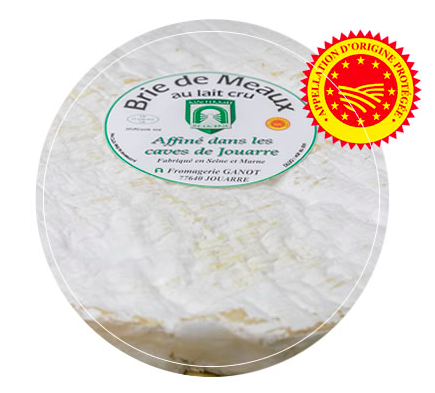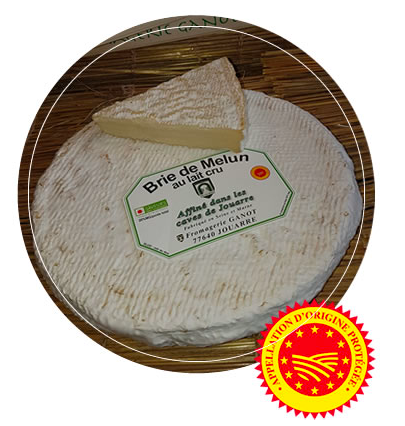Brie de Melun: The wonder of Fromage – unveiling one French cheese at a time
If you come to France and say your favorite cheese is Brie, you’re gonna have to be a bit more specific. The category of Brie encompasses a wide variety of different cheeses, from the pasteurized Brie de Nangis, the recipe for which inspired the Brie exported to the U.S., to the slightly scary-looking Brie noir, a greyish Brie with the texture of Parmesan and a present whiff of ammonia.
There’s Coulommiers, aka Mother Brie, with its Camembert-esque funk. There’s personality-driven Brie de Provins and fudgy Brie de Montereau, not to mention a host of Bries filled with anything from truffle to mustard. And then, of course, there are the two protected Bries – the only two AOP cheeses in Ile-de-France: Brie de Meaux and Brie de Melun.
Of the two, Brie de Meaux is definitely the better-known, and that’s no surprise. Boasting a milder flavor and a stark white rind, Brie de Meaux boasts a creamy texture and a briny, almost oyster-like aroma beneath the dominant flavors of mushrooms and fallen leaves.
It’s a cheese that’s easy to love. Brie de Melun is another beast entirely.
A True Stinker of a Cheese
When I ask Benoit Gourdon of the Interprofessional Union of both AOP Bries to cite the major similarities between the two kinds of cheese, he laughs. “The only one is the shape,” he says. “Round.”
Quippiness aside, the cheeses truly couldn’t be more different.
- Brie de Meaux is large, thin, and starkly white, weighing an average of about three kilos and measuring around 37 centimeters in diameter.
- Brie de Melun has a far thicker rind dappled with red, orange, or brown splotches, and it’s much smaller, weighing just 1.5 to 2.2 kilos for its 27 centimeters.
And their physical appearance is just the beginning of what distinguishes these two cheeses from one another. “With Meaux, you really get something nutty,” says Gourdon, “whereas with Melun, it’s a bit saltier and more assertive in flavor.”
For Isabelle Hedin, a fifth-generation artisan ager of Brie at the Fromagerie Ganot in Jouarre, it’s unsurprising that many are deterred by the smaller of the two. “Meaux is more accessible, in terms of flavor,” she says, noting that Melun is far more of an acquired taste.
“When you start with Brie de Meaux and then move towards Brie de Melun, you develop a taste for it, bit by bit,” she says. “You should always start with Meaux.”


The Oldest of Bries
If Brie de Melun is saltier and stinkier than its more mild-mannered cousin, it’s due in large part to its method of production.
- Brie de Meaux is made with a rennet fermentation, a common cheesemaking technique whereby an enzyme found in the lining of a calf’s stomach is added to the milk in order to encourage it to split into curds and whey.
- Brie de Melun, on the other hand, is made using lactic fermentation, a technique Sophie Loiseau, a fourth-generation artisan ager of Brie asserts is “the oldest technology for cheeses,” rendering Melun “the oldest of all Bries.” While some would posit that this ancestral fermentation method makes Brie de Melun vegetarian, both Loiseau and Hedin assert that this is not the case and that a small amount of rennet is nevertheless used.
The discrepancy does, however, lead to yet more differences. The larger amount of rennet used for Brie de Meaux – and the less-assertive flavors sought – mean that after just two hours, the curd is ready to be sliced into cubes and molded into Meaux molds.
Brie de Melun, Loiseau explains, undergoes somewhere between 12 and 18 hours of fermentation before being stirred into a grainy sort of soup, which is then transferred into molds. These differences in method lead to, she says, much more complex, intense flavors. And that’s not where the differences end.“
As agers, the biggest difference is that it’s nearly double the aging time.” Whereas Brie de Meaux is aged just seven to eight weeks, she says, “we can go up to 12 or even 14 weeks for a Brie de Melun.”
Loiseau explains
A Rare Cheese




The discrepancy between the two production methods doesn’t just pave the way for greater depth of flavor when it comes to Brie de Melun. The margin of error grows as well.
The curds of Brie de Melun, Loiseau says, are far more fragile than those of Brie de Meaux, and the cheese itself is difficult to age properly, requiring a lot more supervision and care.
“It’s far more difficult to make, and it’s far more difficult to age,” she says. “When it‘s good, it’s exceptionally good, and when it’s not good, it’s really not good.”
It’s perhaps for this reason that it’s also the rarer of the two: About 6,000 tons of Brie de Meaux is produced each year for a mere 230 tons of Brie de Melun.
“It’s what I would call more of a local cheese. It’s less present across France, and that’s why it’s less well-known.”
Benoit Gourdon
“It’s the smallest of any cheese appellation,” says Loiseau. “Because of these difficulties linked to its production and aging.” But while a bad Brie de Melun is bitter and sour, she says, a good one is heavenly. “Truly, when Brie de Melun is aged well, it’s far superior. There are much more complex flavors. When it’s made properly, it’s a great cheese, like Beaufort, like Roquefort. When it’s made properly, it’s splendid.”
But while a bad Brie de Melun is bitter and sour, she says, a good one is heavenly. “Truly, when Brie de Melun is aged well, it’s far superior,” she says. “There are much more complex flavors. When it’s made properly, it’s a great cheese, like Beaufort, like Roquefort. When it’s made properly, it’s splendid.”
Enjoying Brie de Melun
“Brie de Melun is not a cheese that people buy. It’s a cheese you are sold.”
Sophie Loiseau asserts.
The disappointment many have faced when it comes to a poor version of the cheese, she says, means the fromager plays a vital role in explaining what to expect from it – and in guiding consumers toward the perfect one.
A well-aged Brie de Melun comes down firstly to expertise, but second to personal preference.
Parisians, Loiseau says, like their Bries aged until they are runny; locals, meanwhile, like it about ¾ aged, with a thin, chalky center lending a third texture to the cheese that makes it even more enjoyable. “It should be soft but not runny,” she says. “It should really never run. That’s a flaw that makes it too powerful and too bitter.”
Look, instead, for something soft with a cream-colored pate. “And above all, the crust should be nicely colored, with brown splotches,” she adds.
And to accompany Brie de Melun?
Locals also enjoy it with wine: Gourdon prefers Gaillac, a heady wine with a nice tannic structure that can stand up to the cheese.
Such a wine, Hedin asserts, would “dominate” milder Brie de Meaux, rendering it “completely insipid.” “That’s not at all the case with Brie de Melun,” she says. “Of course, it has more flavor, but what makes it interesting is to pair it with other things.”
She cites not just good, red wine, but also “very good bread – maybe a country bread, something with flavor.” “With a very aged Brie de Melun, you could even go with something a little bit sweet,” she muses. “You wouldn’t want to do that with Brie de Meaux, because it could bring out a certain bitterness.”
Loiseau, too, calls for a wine with a bit of structure, be it red or white, or else amber beer. Gourdon, meanwhile, volunteers a pairing possibility that he was pleasantly surprised by: an earthy, tannic black tea.
What is your preference: Brie de Meaux or Brie de Melun? Were you previously aware of the difference? Please leave your comments below.
Image credits
1-2 Fromage Ganot via their website
3-6 Brie de Melun copyright Emily Monaco
Here you can read all articles in this column:
‘The wonder of Fromage – unveiling one French cheese at a time’ by Emily Monaco






